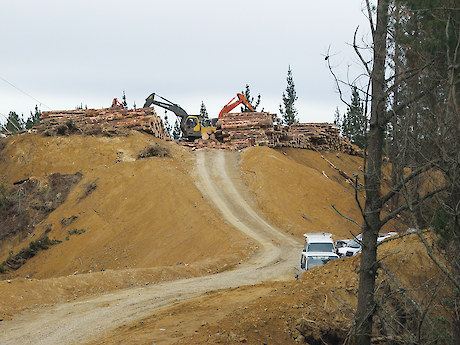 A typical spur road ending at a landingSpur roads are often one lane, and are constructed to a pavement standard that can reliably support short-term logging traffic. They typically provide access to one or two landings, and are used only during harvest and subsequent silvicultural operations. During harvesting, the traffic volume can be heavy and intensive, but they will only be used one to three months in every rotation.
A typical spur road ending at a landingSpur roads are often one lane, and are constructed to a pavement standard that can reliably support short-term logging traffic. They typically provide access to one or two landings, and are used only during harvest and subsequent silvicultural operations. During harvesting, the traffic volume can be heavy and intensive, but they will only be used one to three months in every rotation.
They generally:
- Carry less than 20 heavy vehicles per day or less than 60,000 tonnes per year
- On flat and rolling terrain, have a road width of 4.5 m, desirable maximum adverse grades of 12% or 14% for short distances, and are designed for a speed of 40 km/hr
- On mountainous terrain roads, width might be reduced to 4 m and be designed for speed down to 30 km/hr. This will reduce the amount of earthworks required to construct the road in steep terrain. The maximum adverse grades can be 18% for short distances where the road design and surface has been specifically designed for this.
Again, consider keeping road grades for 50 Max and HPMV trucks to 12.5% adverse loaded for all terrain unless the road is specifically designed for these units. Also incorporate more width on corners for off tracking 50 Max and HPMV than for standard 4 axle trailers.